Overall Impressions
I dove into Minami Lane expecting a simple street builder. Instead, what I got was a charming, bite-sized management sim full of sweetness. Right from the start, the game stands out for its cat-petting mechanics and its slow drip of new features. Unlike larger sims that can overwhelm you, Minami Lane keeps things cozy. In fact, it never dumps a mountain of tasks on you at once. I often compared it to other tiny sims like Dorfromantik or Pocket City, but its focus on villager happiness and pets makes it uniquely heartwarming. My only gripe, however, is that I wanted a little more end-game variety. Still, I loved nearly every minute.
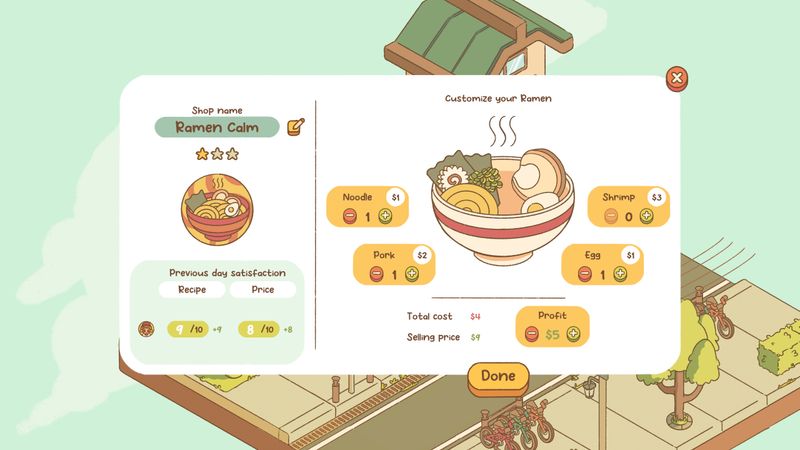
Gameplay Mechanics
At its core, Minami Lane balances population, villager wants, aesthetics, and cats. Each building you add affects those four factors. As you unlock tiny shops—ramen stalls, boba cafés, konbinis, bookstores, florists, and karaoke bars—you master a Mastermind-style logic puzzle. For instance, what do your young shoppers crave, and what delights the elders? You tweak prices, adjust décor, and then simply watch your villagers smile.
Standout moments include unlocking cat levels. I literally squealed when I unlocked my first stray, then petted it for real bonuses. There’s even a 100-pet achievement—cuteness overload! Plus, the game auto-saves villager preferences once you learn them. That feature makes late missions feel smooth, though I also enjoyed flexing my memory skills along the way.
Players report slight clicker bits too—picking up trash, greeting cyclists, hunting tanuki. I adored those little chores because they break up the planning and add sweet variety. Some have found the late-game screen a bit cluttered. I agree that my 20-building street gets busy. But honestly, I loved the chaos—just like a happy, bustling sidewalk.
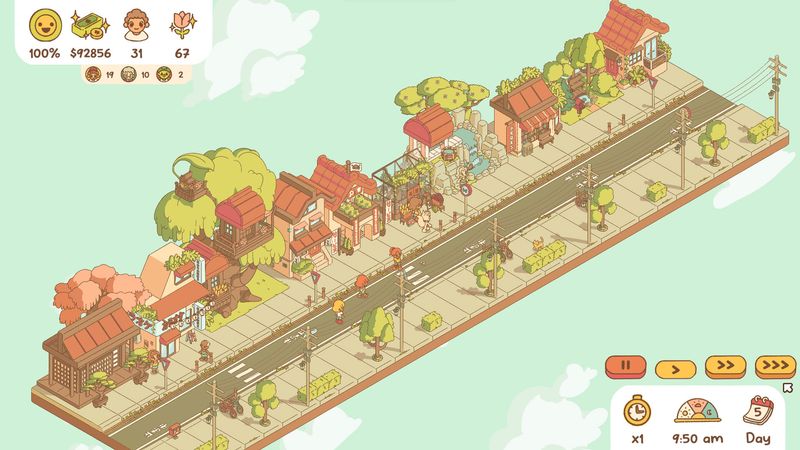
Story and Characters
The story here is simple: restore your tiny street to its former glory and fill your villagers’ hearts with joy. There’s no epic drama, just friendly neighbors and daily quests. I enjoyed meeting diverse villagers of all ages and skin tones. Each one has a small request: “Bring me a book,” or “Let me pet a cat.” Fulfilling these almost feels like helping a friend. The game’s quest lines stay light and charming, with no stressful deadlines. Character arcs are minimal, but the warm tone carries you through. I finished feeling cozy and accomplished.
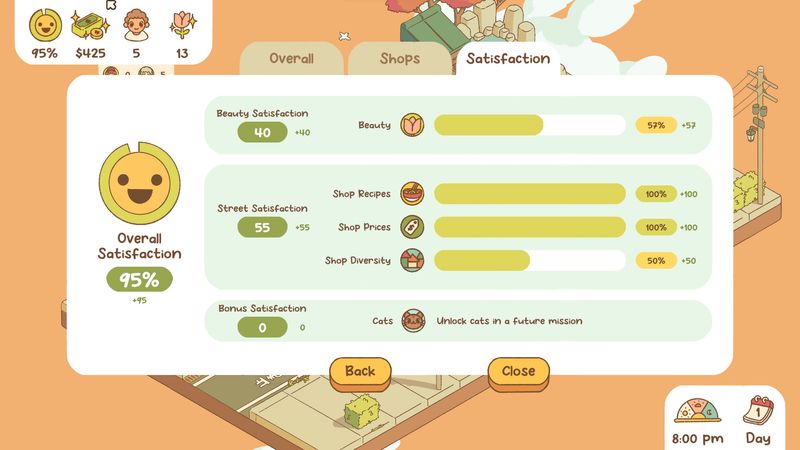
Visuals and Graphics
Minami Lane sports a gorgeous, pastel palette. Every building looks lovingly hand-drawn. The roofs pop with color options, and the greenery upgrades feel lush. The onsen and park tiles add calm, zen vibes to your sidewalk. I found myself taking screenshots of my prettiest blocks. One minor nitpick: once you hit mission five, the screen zoom can’t capture every building at once. I often panned around to pet cats or click cyclists. I didn’t mind the extra scrolling—it felt like strolling down a real street.
Sound and Music
The soundtrack is soft, bouncy, and perfectly cozy. A gentle piano theme plays in menus, switching to light percussion during day and night cycles. The sound effects—clinking ramen bowls, cash register beeps, meows—bring the street to life. No voice acting exists here, but you don’t miss it. The audio design quietly supports the vibe. I found myself humming the main theme on car rides. It never overstays its welcome and loops smoothly each mission.

Difficulty and Replayability
Minami Lane introduces missions at a flattering pace. Mission one feels like a tutorial; by mission five, you juggle every mechanic. Most players finish the story in three to six hours. I clocked about four hours for all main quests and nearly all achievements. After that, the sandbox modes beckon.
There’s a base-level sandbox, where you grow slowly. Then you get a full-creative sandbox with every building from the start. I played a few rounds to tidy up achievements—like “pick up 300 trash items.” But I lacked the urge to rebuild huge streets. The visual clutter and camera limit make large builds tricky. Still, if you love cute layouts, the sandboxes offer open-ended fun. Expect a cozy challenge, not a hardcore sim marathon.
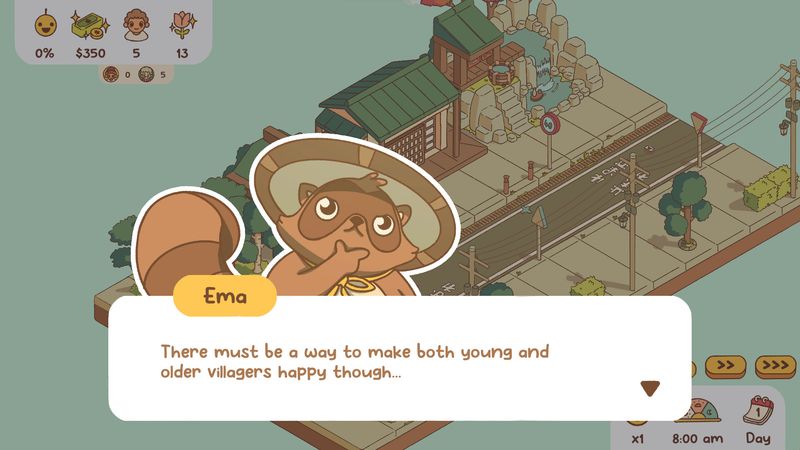
Trivia & Developer Notes
Developer Doot began life as a one-person passion project before evolving into the indie studio Doot Tiny Games, and that spirit of hands-on craftsmanship is evident in every aspect of the game. The beloved cat-petting mechanic, for example, wasn’t an afterthought but the result of months of carefully fine-tuning code until each purr and brush of the fur felt just right. When fans clamored for tanuki-themed cosmetics in the Steam Points shop, the team at Doot didn’t just take note—they loved the idea so much they’re considering a free update to bring those charming skins to life. And thanks to its simple control scheme and responsive UI, the game delivers a flawless experience on Steam Deck, ensuring that whether you’re at home or on the go, Doot Tiny Games’ creation runs just as smoothly as it was meant to.
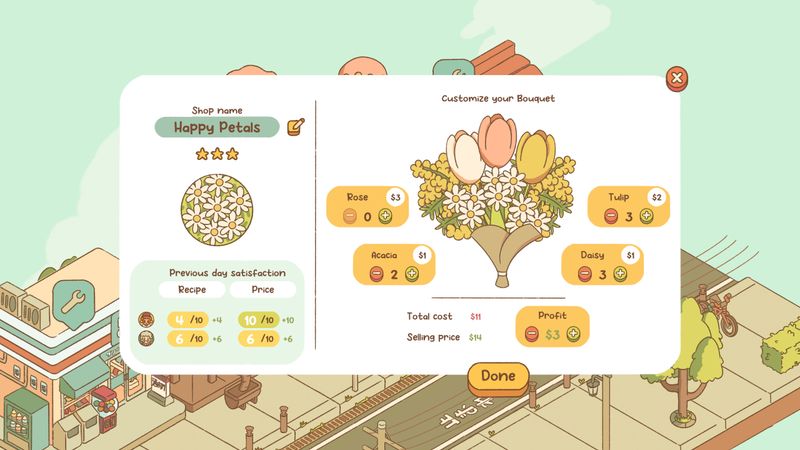
Rating: 4 out of 5 stars

Minami Lane wins hearts with its cozy gameplay, adorable cats, and friendly pace. It loses half a star for limited post-campaign variety and occasional screen clutter. But if you love stress-free sims, this $5 gem is a must-try. I gladly recommend it to casual players, cozy seekers, and anyone who needs a sunny little street in their life.

